

 |
 |
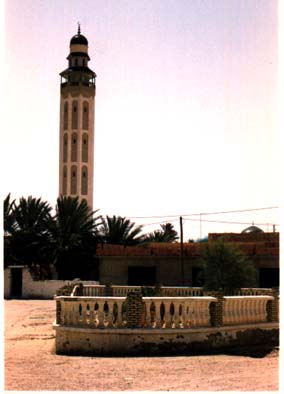 Tozeur is very much a city
relying on tourism, but everything is done in a tasteful manner.
Early developers understood that it was the traditions and culture
that represented the possibilities for the future. While
agriculture remains an important income, tourism employs a large
part of the 20,000 inhabitants, though the city appears to hold
more people. But it is not only the lifestyle and the specific
architecture of Tozeur, that bring tourists out here. The city is
well situated at the fringe of the seasonal large lake Chott
el-Jerid.
Tozeur is very much a city
relying on tourism, but everything is done in a tasteful manner.
Early developers understood that it was the traditions and culture
that represented the possibilities for the future. While
agriculture remains an important income, tourism employs a large
part of the 20,000 inhabitants, though the city appears to hold
more people. But it is not only the lifestyle and the specific
architecture of Tozeur, that bring tourists out here. The city is
well situated at the fringe of the seasonal large lake Chott
el-Jerid.
The 250,000 date palms, and all the vegetation in between, get the
water from 200 springs. The entire oasis is about 11 sq km, with
Tozeur as the large centre, but there are small settlements
scattered around the area. Houses along the main streets are
covered by rectangular yellow bricks, that are making patterns
when they are arranged in two levels. The result is one of the
most distinct and beautiful architectures of Tunisia. As all
houses now are turning to this style (you can still see some
houses where the bricks are added to walls that are far from any
need of restorations), the stunning effect now found in Ave
Bourgiba will dominate the whole city.
 Around the city, nature is far from flat, and tiny valleys and
riverbeds are found all over. Between the palms that are
penetrating the city from all sides, a complicated irrigation
system is found, together with plants and trees, that gives plums,
grapes and strawberries
Around the city, nature is far from flat, and tiny valleys and
riverbeds are found all over. Between the palms that are
penetrating the city from all sides, a complicated irrigation
system is found, together with plants and trees, that gives plums,
grapes and strawberries .
.
Tozeur has also got one of the best museums of Tunisia, which at a
high entrance fee, has exhibitions depicting life among both
ordinary and the rich in times no bygone. Instead of the normal
bus driver uniforms, the personnel here wears traditional costume,
and whenever you find a corner without other visitors, you can
imagine what Tunisia a hundred years ago was like.
As for small details, this almost metropolitan city has
surprisingly many bike cycles,- very rare in Tunisia, and quite a
number of women in black veils covering everything.
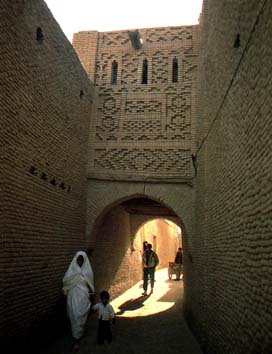 Air
planes run from an airport 4 km from town center, and this serves
Tunis and Jerba, plus Paris, France (!). Buses serve all
imaginable destinations, and as always in Tunisia, offers
excellent value. Only to be matched by the taxis, which are
slightly more expensive, but often faster. A map will indicate
railway connection for Tozeur, but this doesn't operate anymore.
Air
planes run from an airport 4 km from town center, and this serves
Tunis and Jerba, plus Paris, France (!). Buses serve all
imaginable destinations, and as always in Tunisia, offers
excellent value. Only to be matched by the taxis, which are
slightly more expensive, but often faster. A map will indicate
railway connection for Tozeur, but this doesn't operate anymore.
People with need of independent traveling can hire mopeds for
trips around the oasis, or cars from local offices.
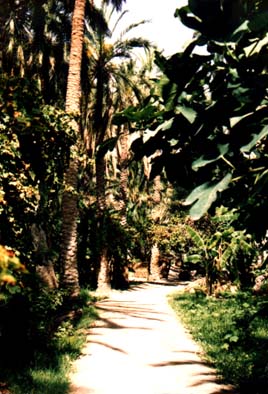

 As
Tozeur represents a little bit shorter trip, Nefta gets far less visitors than its
neighbor city. Apart from that, the two settlements offer much the same: The same architecture and oases of about the same size. But there are things that keep Nefta distinct from Tozeur. The gully cutting Nefta in two parts, gives the the town a dramatic setting. The gully has been used as the base of much activity from religious personalities, and many white tombs, zawiyyas have been put up around here, and Nefta has a status of holy city and a
center of Sufism (mystical subgroup in Islam). In the northern end of the gully a hot spring has been turned into bathing pools for both sexes.
As
Tozeur represents a little bit shorter trip, Nefta gets far less visitors than its
neighbor city. Apart from that, the two settlements offer much the same: The same architecture and oases of about the same size. But there are things that keep Nefta distinct from Tozeur. The gully cutting Nefta in two parts, gives the the town a dramatic setting. The gully has been used as the base of much activity from religious personalities, and many white tombs, zawiyyas have been put up around here, and Nefta has a status of holy city and a
center of Sufism (mystical subgroup in Islam). In the northern end of the gully a hot spring has been turned into bathing pools for both sexes.
The oasis is made up of 300,000 date palms, where 70,000 are deglas, date palms of supreme quality. Water comes from 150 springs, and the setting is picturesque with all the narrow roads running through the groves, and is a perfect place for seeking refuge from the sun, if you make your visit during the summer.

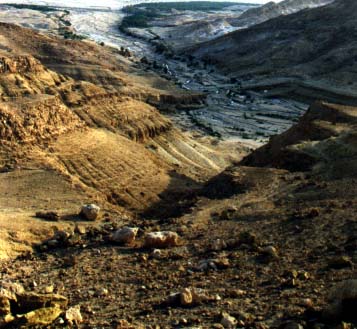
 En traversant une
plaine aride, brulйe par le soleil, on se dirige vers les contreforts de
l'Atlas. Nichйs dans cette montagne ou rien ne pousse, au hasard de la
route, on peut apercevoir des espaces de verdure luxuriante : les oasis de
montagne
En traversant une
plaine aride, brulйe par le soleil, on se dirige vers les contreforts de
l'Atlas. Nichйs dans cette montagne ou rien ne pousse, au hasard de la
route, on peut apercevoir des espaces de verdure luxuriante : les oasis de
montagne
Chebika, la premiиre de ces oasis, est placйe au croisement de deux avancйes de la montagne. Le vieux village surplombe une gorge oщ coule l'oued qui a donnй naissance а cet оlot de verdure.

 Mides is little visited,
primarily because communications here, in Sahara, and near the
Algerian border, are bad. The setting of Mides is striking, and
the surroundings offer splendid scenes for photographers. The
village of Mides is looking over a small, but dramatic canyon,
that is distinct with its round shapes, and strong contrasts in color.
The village is no more than a handful of white houses,
where the main attraction are the smiling and curious children.
the settlement is quite new, as theder.
Mides is little visited,
primarily because communications here, in Sahara, and near the
Algerian border, are bad. The setting of Mides is striking, and
the surroundings offer splendid scenes for photographers. The
village of Mides is looking over a small, but dramatic canyon,
that is distinct with its round shapes, and strong contrasts in color.
The village is no more than a handful of white houses,
where the main attraction are the smiling and curious children.
the settlement is quite new, as theder.
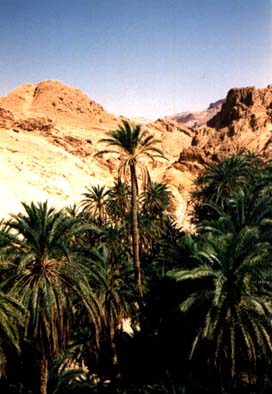 There are a group of oases
west of Metlaoui,
offering some of the most spectacular sights of Tunisia, but they
are little visited. Of these Tamerza is the one that is easiest to
visit, as it has public transportation. Tamerza is situated with a
green palmeraie in a relatively wide valley, and the town itself
is divided in two parts. The new town is not very inspired, but
the old one is walled, and offer some good examples of traditional
architecture.
There are a group of oases
west of Metlaoui,
offering some of the most spectacular sights of Tunisia, but they
are little visited. Of these Tamerza is the one that is easiest to
visit, as it has public transportation. Tamerza is situated with a
green palmeraie in a relatively wide valley, and the town itself
is divided in two parts. The new town is not very inspired, but
the old one is walled, and offer some good examples of traditional
architecture.
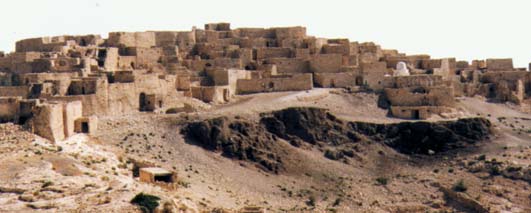
![]()